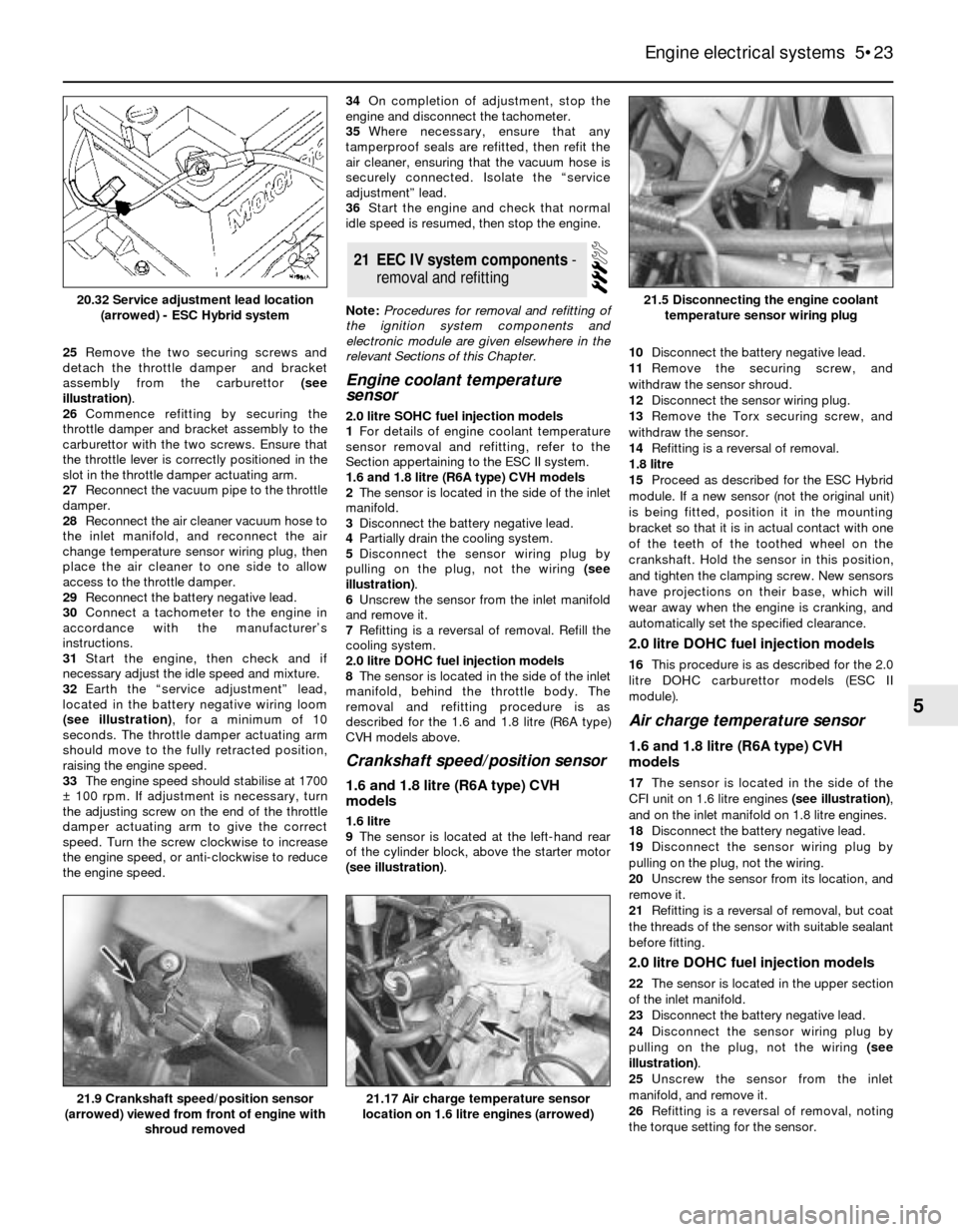clock setting FORD SIERRA 1990 2.G Engine Electrical Systems Workshop Manual
[x] Cancel search | Manufacturer: FORD, Model Year: 1990, Model line: SIERRA, Model: FORD SIERRA 1990 2.GPages: 24, PDF Size: 0.93 MB
Page 23 of 24

25Remove the two securing screws and
detach the throttle damper and bracket
assembly from the carburettor (see
illustration).
26Commence refitting by securing the
throttle damper and bracket assembly to the
carburettor with the two screws. Ensure that
the throttle lever is correctly positioned in the
slot in the throttle damper actuating arm.
27Reconnect the vacuum pipe to the throttle
damper.
28Reconnect the air cleaner vacuum hose to
the inlet manifold, and reconnect the air
change temperature sensor wiring plug, then
place the air cleaner to one side to allow
access to the throttle damper.
29Reconnect the battery negative lead.
30Connect a tachometer to the engine in
accordance with the manufacturer’s
instructions.
31Start the engine, then check and if
necessary adjust the idle speed and mixture.
32Earth the “service adjustment” lead,
located in the battery negative wiring loom
(see illustration), for a minimum of 10
seconds. The throttle damper actuating arm
should move to the fully retracted position,
raising the engine speed.
33The engine speed should stabilise at 1700
±100 rpm. If adjustment is necessary, turn
the adjusting screw on the end of the throttle
damper actuating arm to give the correct
speed. Turn the screw clockwise to increase
the engine speed, or anti-clockwise to reduce
the engine speed.34On completion of adjustment, stop the
engine and disconnect the tachometer.
35Where necessary, ensure that any
tamperproof seals are refitted, then refit the
air cleaner, ensuring that the vacuum hose is
securely connected. Isolate the “service
adjustment” lead.
36Start the engine and check that normal
idle speed is resumed, then stop the engine.
Note:Procedures for removal and refitting of
the ignition system components and
electronic module are given elsewhere in the
relevant Sections of this Chapter.
Engine coolant temperature
sensor
2.0 litre SOHC fuel injection models
1For details of engine coolant temperature
sensor removal and refitting, refer to the
Section appertaining to the ESC II system.
1.6 and 1.8 litre (R6A type) CVH models
2The sensor is located in the side of the inlet
manifold.
3Disconnect the battery negative lead.
4Partially drain the cooling system.
5Disconnect the sensor wiring plug by
pulling on the plug, not the wiring (see
illustration).
6Unscrew the sensor from the inlet manifold
and remove it.
7Refitting is a reversal of removal. Refill the
cooling system.
2.0 litre DOHC fuel injection models
8The sensor is located in the side of the inlet
manifold, behind the throttle body. The
removal and refitting procedure is as
described for the 1.6 and 1.8 litre (R6A type)
CVH models above.
Crankshaft speed/position sensor
1.6 and 1.8 litre (R6A type) CVH
models
1.6 litre
9The sensor is located at the left-hand rear
of the cylinder block, above the starter motor
(see illustration).10Disconnect the battery negative lead.
11Remove the securing screw, and
withdraw the sensor shroud.
12Disconnect the sensor wiring plug.
13Remove the Torx securing screw, and
withdraw the sensor.
14Refitting is a reversal of removal.
1.8 litre
15Proceed as described for the ESC Hybrid
module. If a new sensor (not the original unit)
is being fitted, position it in the mounting
bracket so that it is in actual contact with one
of the teeth of the toothed wheel on the
crankshaft. Hold the sensor in this position,
and tighten the clamping screw. New sensors
have projections on their base, which will
wear away when the engine is cranking, and
automatically set the specified clearance.
2.0 litre DOHC fuel injection models
16This procedure is as described for the 2.0
litre DOHC carburettor models (ESC II
module).
Air charge temperature sensor
1.6 and 1.8 litre (R6A type) CVH
models
17The sensor is located in the side of the
CFI unit on 1.6 litre engines (see illustration),
and on the inlet manifold on 1.8 litre engines.
18Disconnect the battery negative lead.
19Disconnect the sensor wiring plug by
pulling on the plug, not the wiring.
20Unscrew the sensor from its location, and
remove it.
21Refitting is a reversal of removal, but coat
the threads of the sensor with suitable sealant
before fitting.
2.0 litre DOHC fuel injection models
22The sensor is located in the upper section
of the inlet manifold.
23Disconnect the battery negative lead.
24Disconnect the sensor wiring plug by
pulling on the plug, not the wiring (see
illustration).
25Unscrew the sensor from the inlet
manifold, and remove it.
26Refitting is a reversal of removal, noting
the torque setting for the sensor.
21EEC IV system components -
removaland refitting
Engine electrical systems 5•23
5
21.9 Crankshaft speed/position sensor
(arrowed) viewed from front of engine with
shroud removed21.17 Air charge temperature sensor
location on 1.6 litre engines (arrowed)
21.5 Disconnecting the engine coolant
temperature sensor wiring plug20.32 Service adjustment lead location
(arrowed) - ESC Hybrid system